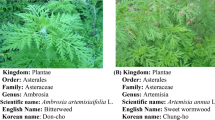Abstract
The composition of the volatile fraction of Egyptian Jasminum sambac (L.) Ait. (Family: Oleaceae) flowers picked in July (the climax of the flowering season), was studied using GC/MS. The flowers’ concrete headspace (HS) volatiles had been analyzed by SPME (solid phase microextraction) and compared with those from the flowers’ absolute. The main volatile constituents of the concrete HS and the absolute, respectively, were: benzyl acetate (23.7 and 14.2%), indole (13.1 and 13.4%), E-E-α-farnesene (15.9 and 13.1%), Z-3-hexenyl benzoate (4.9 and 9.4%), benzyl alcohol (7.7 and 8.4%), linalool (10.6 and 6.3%), and methyl anthranilate (5.0 and 4.7%). The major volatile constituents of Egyptian J. sambac absolute are almost qualitatively similar but quantitatively different from those grown in other geographical regions. The proportion of some major volatile constituents at this investigation are also different from those reported in a previous investigation for Egyptian J. sambac. The study also revealed that, headspace-solid phase microextraction (HS-SPME), equipped with a polydimethylsiloxane (PDMS) fiber, can give an indication about the composition of some of the major volatile constituents of J. sambac, e.g., indole, methyl anthranilate and E-E-α-farnesene, directly from the concrete HS.
Similar content being viewed by others
References
Dadlani N, More T (1996) Ind J Agric Res 30(2):133–141
Watanabe N, Watanabe S, Nakajima R, Moon J, Shimokihara K, Inagaki J, Etoh H, Asai T, Sakata K, Ina K (1993) Biosci Biochem 57(7):101–1106
Inagaki J, Moon J (1995) Biosci Biotech Biochem 59(4):738–739
Zhang Y, Liu Y (1995) Phytochemistry 38:899–903
Moon J, Watanabe N, Sakata K, Inagaki J, Yagi A, Ina K, Luo S (1994) Phytochemistry 36:1435–1437
Ito Y, Sugimoto A, Kakuda T, Kubota K (2002) J Agric Food Chem 50(17):4878–4884
Hara Y, Luo S, Wickremasinghe L, Yamanishi Y (1995) Food Rev Intern 11:409–434
Kapoor J (1991) Perfum Flavor 16(1):21–26
Rao Y, Rout P (2003) J Essen Oil Res 15:398–401
Sun S, Ma Y (1985) Acta Bot Sin 27(2):186–191
He C, Liang Z, Liu H (1999) Tianran, Chanwu, Yanjiu Yu Kaifa 11(3):53–57. See chemical abstract (1999) 132, 90703c
Mookherjee B, Trenkle R, Wilson B (1990) Pure Appl Chem 62:1357–1364
Shalaby A, Hassan H (1989) Ind Perfum 33(4):268–273
Singh R, More T (1986) Ind Perfum 30(1):251–253
Kaiser R (1988) New volatile constituents of J. sambac (L.) Aiton. In: Lawrence B, Mookherjee B, Wills E (eds) Flavors and fragrances: a world perspective. Elsevier, BV Amsterdam, pp 669–684
Kobayashi A, Kubota K, Anzai Y, Cheng M, Yamanishi T (1985) In: Proceedings of the 29th symposium on the chemistry of terpenes, essential oils and aromatics, pp. 129. Mie, Japan. Also reviewed by Lawrence B (1992) Perfum Flavor 17(3):68–71
Wu C, Zhao D, Sun W, Ma P, Wang Q, Lu C (1987) Zhiwu Xuebao 29(6):636–642. Also reviewed by Lawrence B (1994) Perfum Flavor 19:(March–April), pp 64–69
Rao Y, Rout P (2002) Ind Perfum 46(1):49–53
Zhu L, Li Y, Li B, Lu B, Xia N (1993) Aromatic plants and essential constituents. South China Institute of Botany, Chinese Academy of Science, Hai Feng Publisher Co, distributed by Peace Book Co Ltd, Hong Kong. Also reviewed by Lawrence B (1994) Perfum Flavor 19:(March–April), pp 64–69
Chaput A, Gardou C, Huddadi D, Jullien E, Moustafa E, Saint-Jaim Y (1982) Etude sur les composantes de l’absolut de “foll” egyptien. Proceedings VIIIth International Essential Oil Congress, Cannes, FEDAROM, Grass, pp 210–214. Also reviewed by Lawrence B (1994) Perfum Flavor 19:(March–April), pp 64–69
Tamogami S, Awano K, Kitahara T (2001) Flavour Fragr J 16:161–163
Boyd-Boland A, Chai M, Luo Y, Zhang Z, Yang M, Pawliszyn J, Gorecki T (1994) Environ Sci Technol 28:569A–574A
Adams RP (2001) Identification of Essential Oil Components by Gas Chromatography/Quadrupole Mass Spectroscopy, Allured, Illinois
Zhang Z, Pawliszyn J (1993) Anal Chem 65:1843–1848
Young J, Chu C, Lu X, Zhu H (2004) J Agric Food Chem 52:8086–8093
West T, Strausz H, Barton D (1949) Nitrogen containing comounds. In: Synthetic perfumes. Edward Arnold & Co., London, pp 309
Whitaker B, Solomos T, Harrison D (1997) J Agric Food Chem 45:760–765
Duffey S, Underhill E, Towers G (1974) Biochem Physiol (47B):753–766
Xie S, Kato Y, Asano Y (2001) Biosci Biotech Biochem 65(12):2666–2672
Marriott P, Trapp O, Shellie R, Schurig V (2001) J Chromatogr A 919:115–126
Joulain D, Casazza A, Laurent R, Portier D, Guillamon N, Pandya R, Le M, Viljoen A (2004) J Agric Food Chem 52:2322–2325
Author information
Authors and Affiliations
Corresponding author
Rights and permissions
About this article
Cite this article
Edris, A.E., Chizzola, R. & Franz, C. Isolation and characterization of the volatile aroma compounds from the concrete headspace and the absolute of Jasminum sambac (L.) Ait. (Oleaceae) flowers grown in Egypt. Eur Food Res Technol 226, 621–626 (2008). https://doi.org/10.1007/s00217-007-0623-y
Received:
Revised:
Accepted:
Published:
Issue Date:
DOI: https://doi.org/10.1007/s00217-007-0623-y




